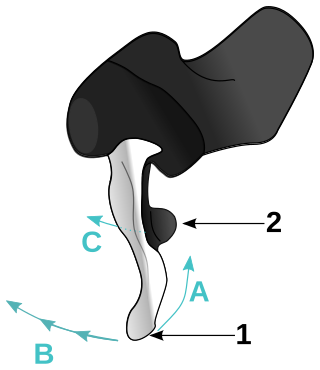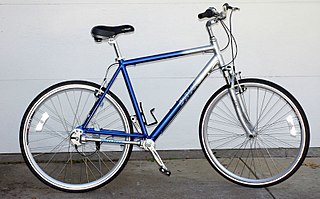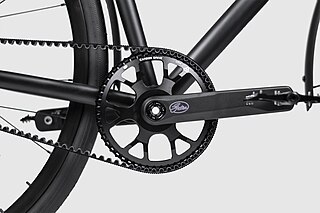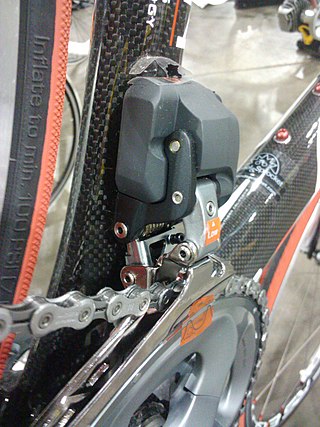
A derailleur is a variable-ratio bicycle gearing system consisting of a chain, multiple sprockets of different sizes, and a mechanism to move the chain from one sprocket to another.

A hub gear, internal-gear hub, internally geared hub or just gear hub is a gear ratio changing system commonly used on bicycles that is implemented with planetary or epicyclic gears. The gears and lubricants are sealed within the shell of the hub gear, in contrast with derailleur gears where the gears and mechanism are exposed to the elements. Changing the gear ratio was traditionally accomplished by a shift lever connected to the hub with a Bowden cable, and twist-grip style shifters have become common.

A bicycle chain is a roller chain that transfers power from the pedals to the drive-wheel of a bicycle, thus propelling it. Most bicycle chains are made from plain carbon or alloy steel, but some are nickel-plated to prevent rust, or simply for aesthetics.

The Birdy is a folding bicycle designed by Riese und Müller in Germany and produced by Pacific Cycles in Taiwan. As of 2010 over 100,000 had been sold. Three distinct models have been marketed, in addition to some specialist variations, with the third (Mk3) introduced in July 2015.

Shimano Total Integration (STI) is a gearshift system designed by Shimano for racing bicycles. It combines the braking and gear shifting controls into the same component. This allows shifting gears without having to remove a hand from the bars, unlike previous down tube shifting systems. This component is usually referred to as a "shifter" or "dual-control levers", or occasionally "brifters".
SRAM LLC is a privately owned bicycle component manufacturer based in Chicago, Illinois, United States, founded in 1987. SRAM is an acronym comprising the names of its founders. The company produces a range of cycling components, including Grip Shift, and separate gravel, road, and mountain drivetrains from 7 to 12 speed. SRAM developed the Eagle line of mountain bike specific drivetrain components intended to improve shifting performance. SRAM was also the first to release a dedicated "one by" drivetrain with a single front chain-ring for road bikes.

A shaft-driven bicycle is a bicycle that uses a drive shaft instead of a chain to transmit power from the pedals to the wheel. Shaft drives were introduced in the 1880s, but were mostly supplanted by chain-driven bicycles due to the gear ranges possible with sprockets and derailleurs. Around the 2000s, due to advancements in internal gear technology, a small number of modern shaft-driven bicycles have been introduced.
SR Suntour is a Taiwanese manufacturer of bicycle components, formed in 1988 when Osaka based SunTour (Maeda) went bankrupt and was purchased by Sakae Ringyo Company, a major Japanese maker of aluminum parts, particularly cranks and seat posts. SunTour's sales and commercial success peaked from the late 1970s to the mid-1980s.

On a bicycle, the cassette or cluster is the set of multiple sprockets that attaches to the hub on the rear wheel. A cogset works with a rear derailleur to provide multiple gear ratios to the rider. Cassettes come in two varieties, freewheels or cassettes, of which cassettes are a newer development. Although cassettes and freewheels perform the same function and look almost the same when installed, they have important mechanical differences and are not interchangeable.

A freehub is a type of bicycle hub that incorporates a ratcheting mechanism.

The Rohloff Speedhub is an epicyclic internal hub gear for bicycles, developed and patented by Rohloff AG. It has been manufactured and marketed by that company since 1998. The Speedhub 500/14 has 14 equally spaced, sequential, non-overlapping gear ratios operated by a single twistgrip. The overall gear range is 526%, meaning the highest gear is 5.26 times as high as the lowest gear. Individual gear shifts when shifting up give an increase of about 13.6%.

Bicycle gearing is the aspect of a bicycle drivetrain that determines the relation between the cadence, the rate at which the rider pedals, and the rate at which the drive wheel turns.

A belt-driven bicycle is a chainless bicycle that uses a flexible belt, typically a synchronous toothed design, in order to transmit power from the pedals to the wheel.
Bernhard Felix Rohloff was a German businessman who was the founder of Rohloff AG, and the inventor of several innovative products, amongst others, the 14 speed Rohloff Speedhub 500/14 planetary gear hub.

An electronic gear-shifting system is a method of changing gears on a bicycle, which enables riders to shift with electronic switches instead of using conventional control levers and mechanical cables. The switches are connected by wire or wirelessly to a battery pack and to a small electric motor that drives the derailleur, switching the chain from cog to cog. An electronic system can switch gears faster and, because the system does not use Bowden cables and can calibrate itself, it may require less maintenance.

The Sachs Elan was an epicyclic internal hub gear for bicycles, developed and manufactured by the bicycle division of the German company Fichtel & Sachs. It was considered heavy and production units were plagued with quality issues. The gear hub was discontinued before the turn of the 2000 millennium.

Shimano Nexus is a brand of bicycle components which includes products such as epicyclical gear hubs, cranksets, shifters, brake levers, hub brakes, hub dynamos, and a CPU for automatically changing gears. The series is primarily aimed at the "comfort" market such as urban commuters and tourers, and as such is not made to withstand the rigours of off-road or mountain biking. The free-wheeling Nexus internal gear hubs are compatible with Shimano's "roller brake", its version of a drum brake, but not with the Shimano disc brakes used with the higher-end Shimano Alfine internal gear hubs.
The SRAM i-Motion series of products is a sport, urban, and trekking oriented product series developed and manufactured by SRAM Corporation. Branded i-Motion are internally geared hubs, shift levers, and dynamo hubs. Related to the i-Motion series are also changeable free or fixed single speed hubs, hybrid epicyclic and derailleur gear hubs, and hydraulic disc brakes. The i-Motion series of products were developed at SRAMs Schweinfurt R&D and manufacturing plant in Germany, formerly of Sachs.
This page is a list of internal hub gears for bicycles.














